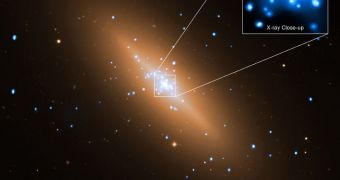For the first time ever, the NASA Chandra X-ray Observatory was able to observe the motion of hot gas towards a black hole. The object was discovered about 32 million light-years away from Earth, and the heart of the large galaxy NGC 3115.
The most recent observations could play an important role in determining how matter behaves in close proximity to such a dark behemoth. Experts have been trying to figure this out for years, but this far to no avail. But the work also carries other important implications.
The most important of these is gaining a better understanding of the processes that lead to the growth of black holes. Knowing how this happens is very important towards gaining a new perspective on how the Universe looked like when it was just a fraction of its current age and size.
In the past, other studies conducted on the areas around black holes revealed the existence of massive volumes of dust and gas in close proximity to the singularities, but no other telescope was able to provide an image as clear as Chandra.
According to experts at NASA, the new datasets provide the clearest signature of hot gas ever produced. The fact that NGC 3115 is located nearby was also of help in this new investigation.
Chandra managed to observe the critical threshold at which the motion of gas spinning around in the accretion disk of a black hole becomes dominated by the gravitational pull of the dark behemoth. Once this limit is reached, the gas gets sucked in. This distance is known as the Bondi radius.
“It's exciting to find such clear evidence for gas in the grip of a massive black hole. Chandra's resolving power provides a unique opportunity to understand more about how black holes capture material by studying this nearby object,” investigator Ka-Wah Wong says.
The scientist holds an appointment as an astronomer at the University of Alabama. He was also the leader of the new investigation, details of which appear in a paper published in the July 20 issue of the Astrophysical Journal Letters.
“A leading mystery in astrophysics is how the area around massive black holes can stay so dim, when there's so much fuel available to light up. This black hole is a poster child for this problem,” adds UA study coauthor Jimmy Irwin.
The new data will be used to improve models that account for how materials flow into a black hole. Learning how they accrete matter will reveal the objects' growth patterns, which will in turn enable astrophysicists to study their evolution through time.

 14 DAY TRIAL //
14 DAY TRIAL //